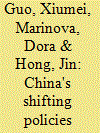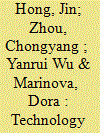| Srl | Item |
| 1 |
ID:
120814


|
|
|
|
|
| Publication |
2013.
|
| Summary/Abstract |
China is currently not only the most populous country on earth, but also the world's largest greenhouse gas (GHG) emitter. As China's population growth continues contributing to the overall global population increase, the country remains a significant player in the global problems related to climate change. The Chinese government, however, has recognized that a low-carbon economy is in the country's long-term economic and social interests and this is now a key part of its national development strategy. This paper examines the evolution of policies for sustainability in China and explores their compositions, functions and operational mechanisms. Some emerging features and trends in China's development model are examined, arguing that they represent a clear shift towards sustainability. Further problems and challenges associated with this change and how they impact on China's policies and strategies are also discussed.
|
|
|
|
|
|
|
|
|
|
|
|
|
|
|
|
| 2 |
ID:
122947


|
|
|
|
|
| Publication |
2013.
|
| Summary/Abstract |
The paper presents an alternative approach to explain why regional productivity is different across regions by utilizing the creative class approach in China. First, we analyze the extent of spatial agglomeration of the creative class across regions in China. Second, we develop a model with spatial externalities to investigate how the concentration of the creative class can promote regional productivity. Our analysis confirms the importance of spatial agglomeration of the creative class in stimulating regional productivity. The results also imply that regional productivity is greater in markets with higher levels of innovation, capital stock, manufacturing and urbanization. In light of the results of our analysis, we discuss a number of policy implications.
|
|
|
|
|
|
|
|
|
|
|
|
|
|
|
|
| 3 |
ID:
164724


|
|
|
|
|
| Summary/Abstract |
This research adds to the literature studying the effects of outward foreign direct investment (OFDI) on domestic innovation performance and the moderating effect of a technology gap between host and home countries. New definitions of observed technology gap and expected technology gap are proposed. An observed technology gap captures the existing differences in technology level between establishments, regions or countries. An expected technology gap is an indication of the effort of imitating and learning from technology leaders. The corresponding measures and effects of observed and expected technology gaps on OFDI‐induced reverse technology spillover are analyzed. OFDI in developed countries promotes innovation performance. However, OFDI in emerging markets hampers innovation performance. It is also found that regions with a wider observed technology gap and a narrower expected technology gap can benefit more from OFDI.
|
|
|
|
|
|
|
|
|
|
|
|
|
|
|
|